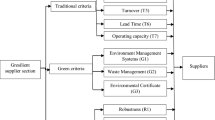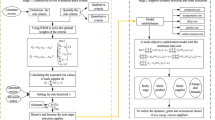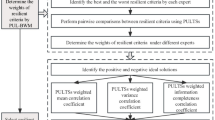Abstract
Disaster studies have recently received considerable attention. Determining how to build a resilient supply chain to mitigate uncertainty is the priority for automotive companies. Supplier selection strategies have been identified as vital for mitigating this uncertainty. This study sought to verify the criteria for selecting suppliers by using global performance measurements to identify optimal supply resources and locations in an uncertain disaster environment. The study focuses on an automotive company case study and evaluates the results through weighted goal programming (WGP) and preemptive goal programming (PGP) methods. The findings are as follows: (1) The investigated automotive company must arrange additional supply resources in the involved region by using a global supplier selection strategy, (2) an appropriate location in the involved region is identified through a global performance measurement and evaluation, and (3) disaster damage mitigation is determined to be a priority in long-term business strategies. This case study improves the preparedness of the automotive industry to manage unpredictable disasters in the supply chain through the effective use of a global selection strategy.
Similar content being viewed by others
Explore related subjects
Discover the latest articles, news and stories from top researchers in related subjects.References
Aktar DE, Ozden U (2008) An integrated multi-objective decision making process for supplier selection and order allocation. Omega 36:76–90
Amid A, Ghodsypoura SH, O’Brien C (2006) “Fuzzy multi-objective linear model for supplier selection in a supply chain”. Int J Prod Econ 104:394–407
Lee HIA (2009) A fuzzy supplier selection model with the consideration of benefits, opportunities, costs and risks”. Expert Syst Appl 36:2879–2893
Bevilacqua M, Ciarapica FE, Giacchett G (2006) A fuzzy-QFD approach to supplier selection. J Purch Supply Manag 12:14–27
Bellman RG, Zadeh LA (1970) Decision making a fuzzy environment. Manag Sci 17:B141–B164
Boran FE, Genc S, Kurt M, Akay D (2009) A multi-criteria intuitionistic fuzzy group decision making for supplier selection with TOPSIS method. Expert Syst Appl 36:11363–11368
Carvalho H, Barroso PA, Machado HV, Azevedo S, Cruz-Machado V (2012) Supply chain redesign for resilience using simulation. Comput Ind Eng 62:329–341
Chen YJ (2011) Structured methodology for supplier selection and evaluation in a supply chain. Inf Sci 181:1651–1670
Chen CT, Lin CT, Huang S-F (2006) “A fuzzy approach for supplier evaluation and selection in supply chain management”. Int J Prod Econ 102:289–301
De Boer L, van Leo W, Telgen J (1998) Outranking methods in support of supplier selection. J Purch Supply Manag 4:109–118
De Boer L, Labro E, Morlacchi P (2001) A review of methods supporting supplier selection. J Purch Supply Manag 7:75–89
Dulmin R, Mininno V (2003) Supplier selection using a multi-criteria decision aid method. J Purch Supply Manag 9:177–187
Faris CW, Robinson PJ, Wind Y (1967) Industrial buying and creative marketing. Allyn & Bacon, Boston
Felix CTS, Kumar N (2007) Global supplier development considering risk factors using fuzzy extended AHP-based approach. Omega 35:417–431
Felix CTS, Kumar N, Tiwari MK, Lau HCW, Choy KL (2008) Global supplier selection: a fuzzy-AHP approach. Int J Prod Res 46(14):3825–3857
Gary ZJ (2013) Purchasing and the management of materials. 7th Edition by John Wiley & Sons, Inc
Ghodsypour SH, O’Brien C (1998) “A decision support system for supplier selection using an integrated analytic hierarchy process and linear programming”. Int J Prod Econ 56–57:199–212
Ghodsypour SH, O’Brien C (2001) “The total cost of logistics in supplier selection, under conditions of multiple sourcing, multiple criteria and capacity constraint”. Int J Prod Econ 73:15–27
Hang HG, Chan PS, Sik JD, Min RH (2005) An effective supplier selection method for constructing a competitive supply-relationship”. Expert Syst Appl 28:629–639
Ho HS, Ramayya K (2008) A hybrid approach to supplier selection for the maintenance of a competitive supply chain. Expert Syst Appl 34:1303–1311
Ho W, Xu X, Dey KP (2010) Multi-criteria decision making approaches for supplier evaluation and selection: a literature review. Eur J Oper Res 202:16–24
Humphreys PK, Wong YK, Chan FTS (2003) Integrating environmental criteria into the supplier selection process. J Mater Process Technol 138:349–356
Klibi W, Martel A (2012) Modeling approaches for the design of resilient supply networks under disruptions. Int J Prod Econ 135:882–898
Kumar A, Jain V, Kumar S (2014) A comprehensive environment friendly approach for supplier selection. Omega 42:109–123
Liao Z, Rittscher J (2007) “A multi-objective supplier selection model under stochastic demand conditions”. Int J Prod Econ 105:150–159
Martin C, Peck H (2004) Building the resilient supply chain. Int J Logist Manag 15(2):1–13
Ng WL (2008) An efficient and simple model for multiple criteria supplier selection problem. Eur J Oper Res 186:1059–1067
Onut S, Kara SS, Elif I (2009) Long term supplier selection using a combined fuzzy MCDM approach: a case study for a telecommunication company. Expert Syst Appl 36:3887–3895
Rhee VB, Verma R, Plaschk G (2009) “Understanding trade-offs in the supplier selection process: the role of flexibility, delivery, and value-added services/support”. Int J Prod Econ 120:30–41
Riedl FD, Kaufmann L, Zimmermann C, Perols LJ (2013) Reducing uncertainty in supplier selection decisions: antecedents and outcomes of procedural rationality. J Oper Manag 31:24–36
Rifai A (1996) A note on the structure of the goal-programming model: assessment and evaluation. J Oper Manag 16:40–49
Sakawa M (1993) Fuzzy Sets and Interactive Multi-objective Optimization. Plenum Press, New York
Samuel HH, Harshal K (2007) “Comprehensive and configurable metrics for supplier selection”. Int J Prod Econ 105:510–523
Sanayei A, Mousavi SF, Yazdankhah A (2010) Group decision making process for supplier selection with VIKOR under fuzzy environment. Expert Syst Appl 37:24–30
Sawik T (2010) Single vs. multiple objective supplier selection in a make to order environment. Omega 38:203–212
Shaw K, Shankar R, Yadav SS, Thakur SL (2012) Supplier selection using fuzzy AHP and fuzzy multi-objective linear programming for developing low carbon supply chain. Expert Syst Appl 39:8182–8192
Sheffi Y (2005) “Building a resilient supply chain”. Harvard Bus Rev, 1(08)
Swift OC (1995) Preferences for single sourcing and supplier selection criteria. J Bus Res 32:05–111
Tang SC (2006) “Perspectives in supply chain risk management”. Int J Prod Econ 103:451–488
Tang SC, Tomlin B (2008) The power of flexibility for mitigating supply chain risks. Int J Prod Econ 116:12–27
Thomas CY, Janet HL (1996) An exploration supply selection practices across the supply chain. J Oper Manag 14:333–343
Timmerman E (1987) An approach to vendor performance evaluation. IEEE Technol Soc Mag 15(3):14–20
Tsai YL, Yang YJ, Lin CH (2010) A dynamic decision approach for supplier selection using ant colony system. Expert Syst Appl 37:8313–8321
Tseng ML, Chiang JH, Lan WL (2009) Selection of optimal supplier in supply chain management strategy with analytic network process and choquet integral. Comput Ind Eng 57:330–340
Ustun O, Demitras EA (2008) An integrated multi-objective decision-making process for multi-period lot-sizing with supplier selection. Omega 36:509–521
Verma R, Pullman EM (1998) An analysis of the supplier selection process. OMEGA Int J Manag Sci 26(6):739–750
Vokurka RJ, Joobin C, Lakshmi V (1996) A prototype expert system for the evaluation and selection of potential suppliers. Int J Oper Prod Man 16(12):106–127
Wang JW, Cheng CH, H. K. C (2009) Fuzzy hierarchical TOPSIS for supplier selection. Appl Soft Comput 9:377–386
Wisner KL, Sit DK, Hanusa BH, Moses-Kolko EL (2009) Major Depression and antidepressant treatment: impact on pregnancy and neonatal outcomes. Am J Psychiatry 166(5):557–566
Wisner DJ, Tan KC, Leong GK (2012) Supply chain management: a balanced approach south-western 3rd version
Wu W-Y, Sukoco MB, Li C-Y, Shu HC (2009) An integrated multi-objective decision-making process for supplier selection with bundling problem. Expert Syst Appl 36:2327–2337
Xia W, Wu Z (2007) Supplier selection with multiple criteria in volume discount environments. Omega 35:494–504
Yucel A, Guneri AF (2011) A weighted additive fuzzy programming approach for multi-criteria supplier selection. Expert Syst Appl 38:6281–6286
Zenz G (1981) Purchasing and the Management of Materials. Wiley, New York
Zimmermann HJ (1987) Fuzzy sets, decision making and expert systems. Kluwer Academic Publishers, Boston
Zimmermann HJ (1993) Fuzzy sets theory and its applications, 4th edn. Kluwer Academic Publishers, Boston
Author information
Authors and Affiliations
Corresponding author
Appendix
Appendix
Supplier selection criteria defined from literatures:
-
a
Finance: profitability, cost (of product, logistics, tariff, and taxes), gross profit rate, quantity discount, markup (contractual percentage of reduction in unitary overhead related to unitary direct manufacturing costs), costs for buying environmentally friendly material, costs for buying new equipment, redesign of product costs, staff training costs, recycling costs, return on assets, price (of material, assembly, transportation, management, and negotiation), accountability, incentives, reciprocal of price index, cost of ordering parts, unit price of parts required for customers, quantity discounts, business volume discount, factor price, fixed cost, and variable cost
-
b
Quality: conformance to specification, product reliability, quality assessment technique process capability, product quality, quality system (presence or absence of quality certifications), production facilities, quality management intention (QMI), quality system outcome, claims, quality improvement, yield rate, reliability, repair ability, quality rejection rate, expected/acceptable defect rate, technical level, and defects
-
c
Delivery: punctuality of delivery, delivery performance, lead time, on-time delivery rate, delivery flexibility, programming of delivery, processing time (the time needed to develop product structural design), prototyping time (speed in constructing prototypes), design revision time (flexibility to accept and perform project revisions), service (on-time delivery, ease of communication, response to changes, and process flexibility), response to claims, accuracy, lead time, location, reciprocal of distance, number of delivery patterns, and acceptable late delivery rate
-
d
Relationship: technique cooperation, market cooperation, cooperative time, % acceptable long-term suppliers, joint growth, relationship building, trust, credibility, consistency, mutual trust, ease communication, order delays, inability to meet further requirements, and long-term relationship
-
e
Service: customer, availability to support customer, supplier service performance (delivery reliability, information sharing, flexibility and responsiveness, and customer response), customer complaints, service standard, responsiveness, improvement capability, attitude, communication, response speed, degree of communion, use of technology, professionalism of salesperson, responsiveness to customer needs, problem solving, assembling services, online ordering, number of required parts for customers, customer focus, order fulfillment, on-time delivery, supply capacity, repair turn-round time, and warranty period
-
f
Technology and product: R&D rate, process capability, product conformity, codesign (supplier’s effort within the project team), supplier technological levels, supplier technological levels, product development cycle time, product dynamism, time pressure, product familiarity, support to design process, product flexibility, product guarantee, and performance monitoring capabilities
-
g
Supply facility and infrastructure and market reputation, assets, and infrastructure
-
h
Management and organization: (organization control, business plans, customer communication, internal audit, and data administration), honesty and integrity, buyer-supplier fit, strategic commitment of supplier to buyer, safety, institutionalization, flexibility, work experience, competitive priority, strategic purchasing, top management support, information technology, single source or multiple source, alternative, supplier reputation, information system capability, interoperability with other parts, upgradability of hard or software, innovation, research, and development
-
i
Efficacy of corrective action, conflict resolution, and problem solving capabilities
-
j
Environment—carbon footprint (CO2)
-
k
Risk factors: geographical location, political stability and foreign policies, exchange rate and economic position, terrorism and crime rate, supply constraint, and buyer-supplier constraint.
Rights and permissions
About this article
Cite this article
Chen, A., Hsieh, CY. & Wee, H.M. A resilient global supplier selection strategy—a case study of an automotive company. Int J Adv Manuf Technol 87, 1475–1490 (2016). https://doi.org/10.1007/s00170-014-6567-z
Received:
Accepted:
Published:
Issue Date:
DOI: https://doi.org/10.1007/s00170-014-6567-z




